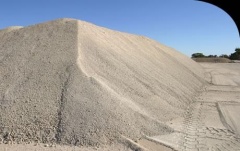Difference between revisions of "Bentonite"
| Line 1: | Line 1: | ||
{{Infobox_Minerals | {{Infobox_Minerals | ||
| image = Bentonite-1.jpg | | image = Bentonite-1.jpg | ||
| − | | origin = | + | | origin = Australia, China, Europe, India, Russia, U.S.A. |
| − | | stowage factor = | + | | stowage factor = 1,14 m/t (bulk) |
| humidity and moisture = - | | humidity and moisture = - | ||
| ventilation = - | | ventilation = - | ||
| − | | risk factors = | + | | risk factors = <ul><li>Moisture damage</li><li>Contamination</li><li>Spillage |
}} | }} | ||
==Description== | ==Description== | ||
Revision as of 09:50, 17 October 2012
| Infobox on Bentonite | |
|---|---|
| Example of Bentonite |  |
| Facts | |
| Origin | Australia, China, Europe, India, Russia, U.S.A. |
| Stowage factor (in m3/t) | 1,14 m/t (bulk) |
| Humidity / moisture | - |
| Ventilation | - |
| Risk factors |
|
Bentonite
Contents
Description
A light coloured powder found in two varieties, Sodium Bentonite and Calcium Bentonite. Shipped in bulk, polythene mesh bags or in multi-ply paper sacks.
Bentonite has been called a clay of a thousand users. Most of bentonites' applications includes the drilling and geotechnical industry. Further used as an additive in cement, adhesives and ceramics. A major application is the use as cat litter. Also used in the cosmetics industry, as a decoloriding agent, in polishes and abrasives, and as a food additive.
Sodium Bentonite is a highly absorbent material which will swell excessively when wet, but Calcium Bentonite has a very low capacity to swell or absorb water.
Full information on this product is in the process of completion.











